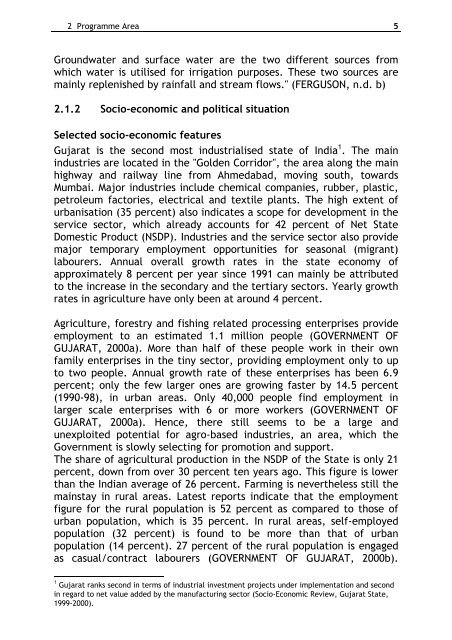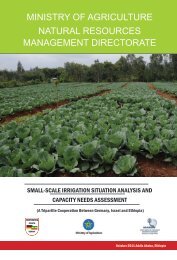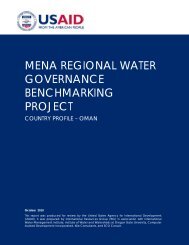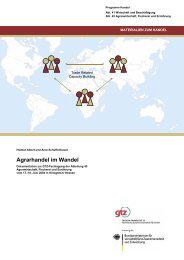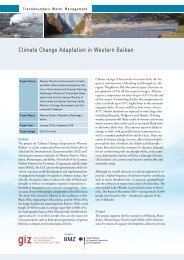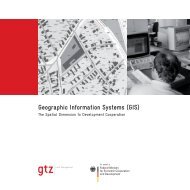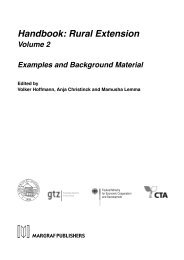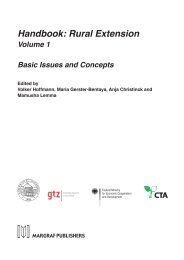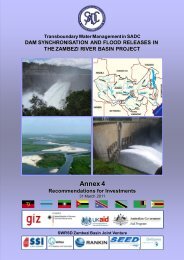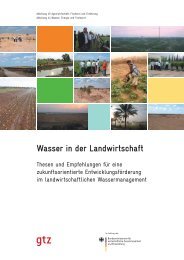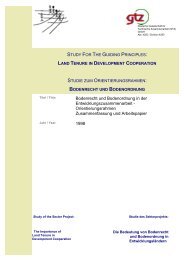Watershed Development in Gujarat - edoc - Humboldt-Universität zu ...
Watershed Development in Gujarat - edoc - Humboldt-Universität zu ...
Watershed Development in Gujarat - edoc - Humboldt-Universität zu ...
You also want an ePaper? Increase the reach of your titles
YUMPU automatically turns print PDFs into web optimized ePapers that Google loves.
2 Programme Area 5Groundwater and surface water are the two different sources fromwhich water is utilised for irrigation purposes. These two sources arema<strong>in</strong>ly replenished by ra<strong>in</strong>fall and stream flows." (FERGUSON, n.d. b)2.1.2 Socio-economic and political situationSelected socio-economic features<strong>Gujarat</strong> is the second most <strong>in</strong>dustrialised state of India 1 . The ma<strong>in</strong><strong>in</strong>dustries are located <strong>in</strong> the "Golden Corridor", the area along the ma<strong>in</strong>highway and railway l<strong>in</strong>e from Ahmedabad, mov<strong>in</strong>g south, towardsMumbai. Major <strong>in</strong>dustries <strong>in</strong>clude chemical companies, rubber, plastic,petroleum factories, electrical and textile plants. The high extent ofurbanisation (35 percent) also <strong>in</strong>dicates a scope for development <strong>in</strong> theservice sector, which already accounts for 42 percent of Net StateDomestic Product (NSDP). Industries and the service sector also providemajor temporary employment opportunities for seasonal (migrant)labourers. Annual overall growth rates <strong>in</strong> the state economy ofapproximately 8 percent per year s<strong>in</strong>ce 1991 can ma<strong>in</strong>ly be attributedto the <strong>in</strong>crease <strong>in</strong> the secondary and the tertiary sectors. Yearly growthrates <strong>in</strong> agriculture have only been at around 4 percent.Agriculture, forestry and fish<strong>in</strong>g related process<strong>in</strong>g enterprises provideemployment to an estimated 1.1 million people (GOVERNMENT OFGUJARAT, 2000a). More than half of these people work <strong>in</strong> their ownfamily enterprises <strong>in</strong> the t<strong>in</strong>y sector, provid<strong>in</strong>g employment only to upto two people. Annual growth rate of these enterprises has been 6.9percent; only the few larger ones are grow<strong>in</strong>g faster by 14.5 percent(1990-98), <strong>in</strong> urban areas. Only 40,000 people f<strong>in</strong>d employment <strong>in</strong>larger scale enterprises with 6 or more workers (GOVERNMENT OFGUJARAT, 2000a). Hence, there still seems to be a large andunexploited potential for agro-based <strong>in</strong>dustries, an area, which theGovernment is slowly select<strong>in</strong>g for promotion and support.The share of agricultural production <strong>in</strong> the NSDP of the State is only 21percent, down from over 30 percent ten years ago. This figure is lowerthan the Indian average of 26 percent. Farm<strong>in</strong>g is nevertheless still thema<strong>in</strong>stay <strong>in</strong> rural areas. Latest reports <strong>in</strong>dicate that the employmentfigure for the rural population is 52 percent as compared to those ofurban population, which is 35 percent. In rural areas, self-employedpopulation (32 percent) is found to be more than that of urbanpopulation (14 percent). 27 percent of the rural population is engagedas casual/contract labourers (GOVERNMENT OF GUJARAT, 2000b).1 <strong>Gujarat</strong> ranks second <strong>in</strong> terms of <strong>in</strong>dustrial <strong>in</strong>vestment projects under implementation and second<strong>in</strong> regard to net value added by the manufactur<strong>in</strong>g sector (Socio-Economic Review, <strong>Gujarat</strong> State,1999-2000).


